- Home
- About us
- Blog
- Shop
- Brands
- ALL Brands List
- Analog Relax
- Antipodes Audio
- Audio Solutions
- AudioByte
- AudioCircle
- Audiomica Laboratory
- Canary Audio
- Canor Audio
- Chameleon Audio
- Dan D'agostino
- Eversolo
- Ferrum Audio
- Fezz Audio
- Glanz
- HiFiMAN
- HoloAudio
- LAB 12
- LAIV
- LampizatOr
- Magico
- Mega Acoustic
- Monrio Audio
- Origin Live
- Phasemation
- Pink Faun
- PLiXIR
- Qualiton
- Reed
- Remton
- Revival Audio
- Riviera Audio
- Rockna Audio
- Sbooster
- Shelter
- Sigma Acoustics
- Signal Projects
- SOtM Audio
- SPEC
- Takatsuki
- Takumi
- Tedeska
- Tellurium Q
- Trafomatic Audio
- Tsakiridis Devices
- Volumio
- Sales
- Second Hand Deals
- Account
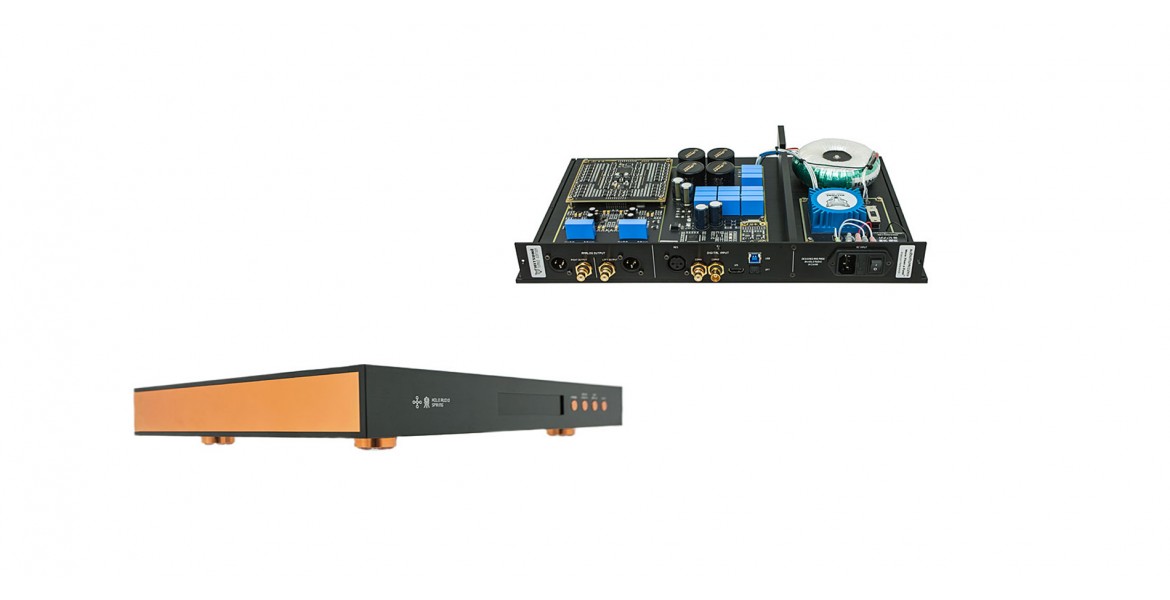
HoloAudio Spring D/A Processor
While covering CanMania at the 2017 Capital Audiofest, I was sitting at the table of HeadAmp Audio Electronics, listening first to John McEuen singing Warren Zevon’s “Excitable Boy,” from McEuen’s Made in Brooklyn (24-bit/192kHz AIFF, Chesky JD388/HDtracks), then to Macy Gray’s Stripped (24/96 AIFF, Chesky JD389/HDtracks). I was listening through HeadAmp’s extraordinary GS-X Mk.2 headphone amplifier ($2999–$3199), but midway through Gray’s “I Try,” I stopped, pulled the Audeze LCD-4 headphones off my head, and asked HeadAmp’s head of sales and marketing, Peter James, what DAC he was using. “Do you know the HoloAudio Spring DAC?” I told him I didn’t, but obviously should. “It’s a ladder DAC, and a lot of my customers use either it or the Schiit Yggdrasil.” I told James that an Yggdrasil anchored my reference CD-spinning system. In my report on CAF 2017, I described what I’d heard: “the quality and texture of the reproduction were unusual. . . .

The music felt different than any I could remember. Surprisingly un-mechanical and clear, but not industrial clear.” There was something unusually sensuous and nondigital going on. I needed to know more about this DAC. On my return to Brooklyn I contacted Tim Connor, whose company, KitsunéHiFi, imports the HoloAudio Spring DAC, which is made in China. Two weeks later, I removed the Schiit Yggdrasil ($2399) and installed the HoloAudio Spring DAC “Kitsuné Tuned Edition” Level 3 ($2499).
Description
The HoloAudio Spring is a member of an interesting but nearly extinct subfamily of D/A converters called R-2R or ladder DACs. Ladder DACs date back to the dawn of digital, and use cascaded voltage dividers consisting of resistors (valued R and 2R) to passively convert pulsing bitstreams to continuous analog voltages. The original Philips/Magnavox CD players of the 1980s were multi-bit R-2R designs whose 14-bit Philips TDA1540 chips used oversampling and noiseshaping to get nominal 16-bit performance. That chip was replaced in 1986 by the TDA1541, a genuine 16-bit R-2R DAC. Around 1990, single-bit sigma-delta chips superseded these benignly musical multi-bit chips. Of course, just as when transistors superseded tubes, not every audiophile thought the new part was an improvement. Some fraternities of audio cognoscenti (most of whom were still using tubes) clung to the TDA1541A, which remained in production until 1995.
The last hope of those who clung to R-2R, Burr-Brown’s venerated PCM1704 24-bit/96kHz chip, was discontinued in 2015. Since then has emerged processors using a new breed of meticulously executed chipless, discrete-resistor ladder DACs, obvious examples of which are the American-made MSB Technology Select DAC ($84,500–$119,985) and the French-made Totaldac d1-six (?13,500). Unfortunately, those DACs’ massive linear power supplies and arrays of discrete, high-stability, low-tolerance resistors are expensive to make. Enter the affordable HoloAudio Spring DAC, a discrete-resistor ladder DAC with an impressive power supply. At only $1499 for the Level 1 version, $1699 for the Rise Ji Edition Level 2, or $2499 for the all-out Kitsuné Tuned Edition Level 3, the Spring reopens the door to the ladder-DAC experience for only a proletarian entrance fee.
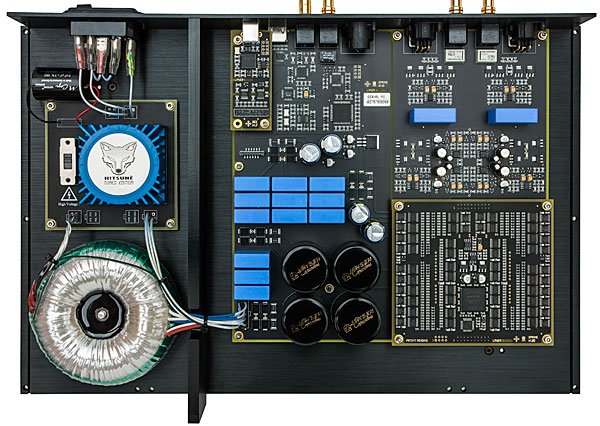
The HoloAudio Spring measures 16.9″ wide by 2.2″ high by 11.8″ deep and weighs 18.75 lbs. Inside its solid case of copper and black-anodized aluminum are two entirely separate, fully balanced converters: a 24-bit, discrete R-2R for PCM, and a discrete resistor network to handle DSD up to DSD512. Both employ designer Jeff Zhu’s patented “linear compensation,” which is not clearly described on KitsunéHiFi’s website but which I imagine is a second (parallel) resistor ladder. According to Zhu (footnote 1), this “will accurately compensate the resistor tolerance.” Regarding the Spring’s unique ability to handle native DSD with a discrete resistor-ladder DAC, “The DSD module of Spring does not use R2R architecture for the DSD, more specifically it uses a very specific architecture which is optimized to perform DSD to analog.” Both modules employ a “paired transistor” op-amp input stage and an output stage employing direct-coupled bipolar junction transistors.

Besides two DAC modules, the Spring also has two completely separate operating modes: non-oversampling (NOS), which bypasses the AKM AK4137 sample rate converter chip used for oversampling, and a choice of three chip-based oversampling (OS) options, selected via a button on the front panel: OS, in which PCM and DSD are each “oversampled” to higher rates but remain PCM and DSD; OS PCM, in which data are “oversampled to PCM”; and OS DSD, in which data are “oversampled to DSD.” The Spring’s balanced output “uses the complete DAC circuit while single-ended uses only half.” On the Spring’s front panel are an easily legible, dimmable display and four substantial copper buttons: NOS/OS, Standby, Display Intensity, and Source Inputs. There is no volume control or remote control. The rear panel provides these inputs: AES/EBU, coaxial RCA and BNC, I2S (HDMI), optical, and USB Type 2.
The USB and I2S inputs accept PCM data up to 32/768 and DSD512, the S/PDIF inputs up to 24/192 and DSD64. The outputs are balanced (XLR) and single-ended (RCA). The Spring sits on impressive silicone-damped copper feet. I listened to the top Spring model, the Kitsuné Tuned Edition Level 3, in which all copper wiring and circuit-board plugs are replaced with 1.5mm wires of pure silver soldered directly to the boards. The IEC inlet capacitor is replaced with a Mundorf silver-foil/oil cap, and the standard fuse with an Audio Horizon Platinum Reference. The Kitsuné Tuned Edition’s “Green Label,” “O-Type” power transformer is hand-wound with 99.99%-pure silver wire. Sitting in my equipment rack, the HoloAudio Spring gave the impression of costing a lot more than $2499. Products sold by KitsunéHifi.com are protected by a 10-day customer-satisfaction policy and a limited 30-day dead-on-arrival (DOA) return policy. HoloAudio (in China) includes a three-year warranty on parts and labor that includes return shipping from HoloAudio to the customer.
Listening
My plan was to first assess the HoloAudio Spring’s basic sound character over several weeks of relaxed listening, then return to my reference DAC, the Schiit Audio Yggdrasil ($2399), and see how that felt. Then I would insert Mytek HiFi’s Brooklyn ($1995) and Manhattan II ($5995) DACs and make further comparisons. Finally, I would return to the HoloAudio and let new impressions and overall conclusions emerge in a natural manner. I listened to all four DACs in balanced mode via AudioQuest Mackenzie XLR interconnects, connected to either the Rogue Audio RH-5 preamplifier driving the Pass Laboratories XA25 power amplifier or Schiit’s Ragnarok integrated amplifier; both amps drove Harbeth’s Monitor 30.2 40th Anniversary Edition loudspeakers. I verified what I heard through the Harbeths via four sets of headphones: Abyss AB-1266 Phi, Focal Utopia, HiFiMan Susvara, and Sony MDR-Z1R.
I began with CDs, decoded with the DAC set to NOS. The first to capture my attention was disc 2 of Memphis Jug Band with Gus Cannon’s Jug Stompers (4 CDs, JSP 7745). These remasterings by John R.T. Davies of recordings from the early days of electrical recording and RCA ribbon mikes seemed less antique and more just right tonally than I remember ever hearing them. More open. More relaxed. The Spring let me feel rhythm changes with my head and rocking shoulders. The sounds of cheap guitars, clay jugs, washtub bass, and washboards played with spoons weren’t just unusually vivid and realistically toned: they displayed a kind of stoned plucking and strumming life energy that characterized Memphis’s Beale Street in the days before the Great Depression. “I Can Beat You Plenty” was strangely and radically lacking in digital oversheen.
The guitar in “Stingy Woman Blues” seemed more authentically wooden than ever. Blown jugs took on the import of a great jazz solo on saxophone. And, like a tiny trumpet played by Miles Davis, Ben Ramey’s kazoo was right there, 6′ in front of me, sounding home-sewn real. Michael Lavorgna, who reviewed the Spring for our sister site AudioStream.com in March 2017, said that it removed what he heard as a “glass wall” between listener and musicians. I noticed that too—it was obvious, and precisely what I mean when I say that the Spring in NOS mode lacked digital oversheen. I’ve played these discs countless times, and can say for certain that the Spring removed something that had previously kept me at sonic and psychic distances from these early recordings’ primal verity.
Spring vs Yggdrasil
Schiit Audio’s Yggdrasil has anchored my main (non–computer-sourced) system since 2016, when I reviewed it for the February 2017 issue. Since then, I’ve found it to be even more vibrant and musically satisfying than I then declared. Now, after weeks of listening to the HoloAudio Spring in NOS mode, I begin to realize that the Yggy’s unglaring palpability, unmolested continuity, and concise temporality might be the results not only of its substantial power supply and proprietary digital filter, but also its non–sigma-delta-ness. The Yggdrasil and Spring delivered music with similar all-natural beauties: no glare bursts, no high-frequency mishegas, no electronic digitalism. Both sounds were strong and vivid, but never, ever in my face. Both had weighty bottom octaves, colorful midranges, and irreproachable top octaves. I removed the Spring and returned to the Yggdrasil midway through Claudio Arrau’s titanic 1976 recording of Liszt’s Piano Sonata in b (CD, Music & Arts 1205), and right away heard obvious differences. The Schiit can be explosively dynamic when fed an impassioned signal like this live AAD recording of a performance at Long Island’s C.W. Post College.
I could immediately feel the muscle of the Schiit’s power supply. The Schiit’s flesh-and-blood vivo matched the 73-year-old Arrau’s dynamic playing in the most riveting way, but strangely, the Yggdrasil focused my attention on the pianist’s forceful keystrokes and the vibrations of his instrument’s soundboard, while the Spring directed my attention almost completely toward such subtleties as the sounds of hammers hitting strings. The Yggy generated big, fierce rhythms; the Spring caused every note to seem unique and artful. Thrilled by the Yggdrasil’s Lisztian Sturm und Drang, I nonetheless missed the Spring’s subtle textural and dynamic intricacies, the literalness of its transparency.
Spring vs Mytek
Comparing the HoloAudio Spring to Mytek HiFi’s Manhattan II ($5995) and Brooklyn ($2195) DACs was a tricky business—the Manhattan II offers seven choices of PCM filter plus the default MQA filter, the Brooklyn three. All of the following observations were made using my preferred minimum-phase, slow-rolloff filters. When I switched from the Spring to the more-than-twice-as-expensive Manhattan II, the first thing I noticed was that the HoloAudio sounded even more tactile and glass-is-gone transparent than the Mytek—which excels at just those traits. On the other hand, the Manhattan II had considerably more bass punch and midrange drive—it reproduced piano in a more exciting, more full-bodied way. But to my surprise, the Manhattan failed to display all those low-level rhythmic, atmospheric, and textural details the Spring had just revealed to me. I was also surprised to hear how differently the Manhattan II and Spring reproduced silence and empty spaces.
The Manhattan’s version of emptiness sounded as if I’d muted the volume; the Spring’s felt like a tangible aspect of a real recording space. Imagine longhaired maestro David Chesky—jazz, classical, and hip-hop composer and performer, producer of recordings and films—playing a 9′ Yamaha concert grand in a deconsecrated Brooklyn church, as you sit right behind the Brüel & Kjaer binaural microphone. I’m talking about Chesky’s The New York Rags (24/192 AIFF, Chesky JD359/HDtracks). Each Rag is a swinging-stride, atonal, boogie-woogie fugal masterpiece. The piano sound is relaxed but vigorous, and luminous in tone. I play this recording often, and so far no DAC has exposed my friend David’s staunch idealism and dreamy humanity—or made his piano sound as weighty or as true of tone—as the HoloAudio Spring.
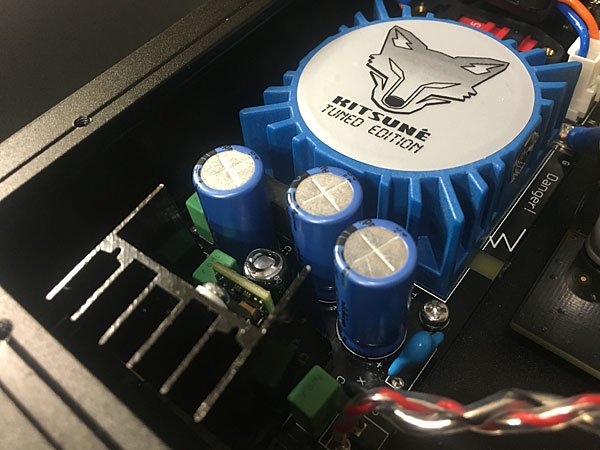
The Schiit, Mytek, and HoloAudio are all elite, music-friendly DACs. I enjoy each in its own way, but my comparisons suggest that staunch audio objectivists—those who already favor DACs with newfangled sigma-delta chips (like the ESS ES9028Pro will undoubtedly prefer the Mytek products. Meanwhile, old-school audio reactionaries—those who favor the purity of single-ended triode amps and the musicality of all those discontinued R-2R DACs—will find the chipless Spring a refreshingly clear and unusually natural-sounding alternative to both sigma-delta and all those discontinued and “obsolete” DAC chips. What most separated the HoloAudio from the Schiit and Mytek DACs was the Spring’s astonishing transparency, which seemed to reach deeper into the digital quiet—especially with DSD recordings.
As you may have guessed, I’ve done more LSD than DSD, but when I do do DSD, I do the purest shit I can find, the Owsley acid of DSD: a download of Puente Celeste’s Nama, recorded by producer and engineer Todd Garfinkle at 5.6MHz using a Korg MR-2000 master recorder (DSDx2, M•A Recordings M084A). Nama is untouched by PCM.
Through the HoloAudio Spring in NOS mode, with the DSD data sourced from my Mac mini via USB, Nama had me grinning like Pigpen at Woodstock. The Spring showed me DSD playback that was not only hyperpure and almost grainless, as it is through the Manhattan II, but distinctly more touchy-feely barefoot and Dionysian nondigital than through the more cerebral-sounding Mytek. Nama is one of the most immediate and raw-sounding digital recordings I know (footnote 2); through the Spring, it was more colorfully whimsical and texturally intense than through the Manhattan II. Nama’s final track, “No Hay Después,” begins with plaintive solo piano, followed by Marcelo Moguilevsky’s soft singing and whistling, then Luciano Dyzenchauz’s bowed double bass emphasizing the dark mood of this meditation on death and the hereafter. It was, unquestionably, the most deeply pleasurable digital experience I have ever had. Speaking of darkness, all three of the Spring’s oversampling modes thickened, blurred, or distorted whatever musical program I applied them to. Each tried its Mephistophelian best to negate the HoloAudio’s divine subtlety, transparency, and realness. So I banished them.
Conclusions
To me, a DAC is just a DAC—until it wipes away digital glare and opens the listening door all the way, letting me enter the plain-truth wonderments of the recordings I collect. And the HoloAudio Spring DAC “Kitsuné Tuned Edition” (Green Label “99.99% Silver” O-Type transformer) aka Level3 did exactly that.
Its sense of undamaged, I-am-there truthfulness let me relax and enjoy my CDs, and DSD and other hi-rez files, with renewed faith in digital sound. While I’m reluctant to give too much credit to the Spring’s R-2R architecture, I do suspect that the chief benefit of ladder DACs is that they don’t require the aggressive noise-shaping and filtering of a delta-sigma DAC—which, in a general way, reminds me of those prescription drugs whose side effects are worse than the disease they’re supposed to cure. The Spring also reminded me how many audiophiles have pursued the latest tricks in hi-rez digital playback in the belief that there somewhere exists some form of recording-studio “master” that, could we get hold of it and our audio gear reproduce it, would allow us to experience what the artists and recording engineers and producers intended. Despite my above-mentioned LSD-DSD experience, I believe this view to be naãve. According to legendary musician and record producer Don Was, now president of Blue Note Records, “what record producers and artists intend for the audience to hear is the first commercially released issue—not some hypothetical master tape or enhanced later version.
By that sensible measure, every remastering, reissue, or change in format—whether from 78 to 331?3rpm, mono to stereo, LP to CD, CD to hi-rez, or hi-rez to MQA—is simply a lower-fidelity interpretation of the original. That’s why I’ve never felt comfortable with remasterings. Now I wonder if the same might be said of delta-sigma’s heavy processing. Such are the questions the HoloAudio Spring’s unadorned naturalness reawoke in me. The unaffected insightfulness of the HoloAudio Spring exposed more of what I imagine was originally aesthetically intended and encoded on my silver discs and invisible files. Consequently, it made me feel that my journey into digital audio may have only just begun.
Sidebar 1: Specifications
Description: Digital-to-analog converter. Inputs: USB, I2S, AES/EBU, 2 coax S/PDIF (RCA, BNC), TosLink. Outputs: single-ended (RCA), balanced (XLR). Output impedance: 200 ohms. Dimensions: 16.9″ (430mm) W by 2.2″ (55mm) H by 11.8″ (300mm) D. Weight: 18.75 lbs (8.5kg).
Finish: Black-anodized aluminum with copper buttons, feet, side panels.
Serial number of unit reviewed: 16075965653.
Manufacturer: HoloAudio, China. US distributor: KitsunéHiFi, 19410 Highway 99, Suite A #366, Lynnwood, WA 98036.
Sidebar 2:Associated Equipment
Digital Sources: Mytek HiFi Brooklyn & Manhattan II, Schiit Audio Yggdrasil DACs; Kitsuné Tuned Edition Singxer SU-1 USB Audio Bridge; Integra DPS-7.2 DVD-A player (as transport), Mac mini computer running Audirvana + 3.2.
Analog Sources: AMG Giro G9 LP player, Linn Sondek LP12 Valhalla turntable with SME M-2 tonearm; Dynavector DV20X2, EMT TSD 75SFL, Koetsu Rosewood Standard, Miyajima Laboratory Saboten cartridges.
Preamplifiers: Pass Laboratories HPA-1, Rogue Audio RH-5.
Power Amplifiers: Pass Laboratories XA25, PrimaLuna ProLogue Premium, Rogers High Fidelity 65V-1.
Integrated Amplifier: Schiit Audio Ragnarok.
Loudspeakers: Falcon Acoustics LS3/5a, Harbeth Monitor 30.2, Stirling Broadcast LS3/5a V2.
Headphones: Abyss AB-1266 Phi, Focal Utopia, HiFiMan Susvara, Sony MDR-Z1R.
Cables: Digital: AudioQuest Cinnamon (USB), Kimber Kable D 60 Data Flex Studio (coaxial), Wireworld Starlight 0.3 (HDMI). Interconnect: AudioQuest Mackenzie, Auditorium 23, Kimber Kable Silver Streak, TriodeWire Spirit, Wireworld Silver Eclipse 7. Speaker: Auditorium 23, TriodeWire American Series. AC: TriodeWire Digital–American Series.
Accessories: Harmonic Resolution Systems M3X-1719, PS Audio PerfectWave PowerBase isolation platforms; Sound Anchor, TonTräger Reference speaker stands.—Herb Reichert
Sidebar 3: Measurements
I measured the HoloAudio Spring DAC “Kitsuné Tuned Edition” Level 3 with my Audio Precision SYS2722 system (see the January 2008 “As We See It”), using both the Audio Precision’s optical and electrical digital outputs and USB data sourced from my MacBook Pro running on battery power with Pure Music 3.0 playing DSD and AIFF test-tone files. Apple’s USB Prober utility identified the Holo Spring as “xCORE USB Audio 2.0” from “XMOS,” its serial number as “0 (none),” and confirmed that its USB port operated in the optimal isochronous asynchronous mode. Apple’s AudioMIDI utility revealed that, via USB, the Spring accepted 24-bit integer data.
Its optical, coaxial, and AES/EBU inputs accepted datastreams with sample rates up to 192kHz, and its USB input accepted streams sampled up to 768kHz! The maximum output level at 1kHz in the Spring’s NOS, OS, and OS PCM modes was 4.95V from the balanced outputs and 2.475V from the unbalanced outputs, the latter 1.85dB higher than the CD standard’s 2V. However, the output levels dropped by 6dB when I switched the Spring to DSD mode. All outputs preserved absolute polarity. (The XLR jacks are wired with pin 2 hot.)
The unbalanced output impedance was close to the specified 200 ohms, at 218 ohms across the audioband. The balanced output impedance was twice that value, as expected. The reconstruction filter’s impulse response in NOS mode was a perfect pulse (fig.1; ignore the tiny amounts of pre- and post-ringing, which are due to the SYS2722’s anti-aliasing filter, operating at a sample rate of 200kHz). When I set the DAC to OS mode with oversampling engaged (the OS PCM and DSD modes behaved identically), the impulse response indicated that the reconstruction filter is a conventional, linear-phase, FIR type (fig.2).


In NOS mode there is no digital reconstruction filter, and with white noise sampled at 44.1kHz (fig.3, magenta and red traces, footnote 1) there is a slow rolloff above the audioband, disturbed by nulls at 44.1 and 88.2kHz. Consequently, the aliased image of a full-scale 19.1kHz tone (cyan and blue traces) was hardly suppressed at all. With the Spring in OS and OS PCM modes, the filter rolled off rapidly above half the sampling frequency, and reached full stop-band suppression at 24kHz (fig.4, magenta and red traces). The image of a full-scale 19.1kHz tone (cyan and blue traces) is therefore suppressed by >100dB.
The distortion harmonics of this tone are very low in level; the third harmonic is the highest in level, at –84dB (0.006%). In DSD mode (fig.5, magenta and red traces) the rolloff above 20kHz is also very steep, but the expected rise in the ultrasonic noise floor due to the DSD encoding is evident.
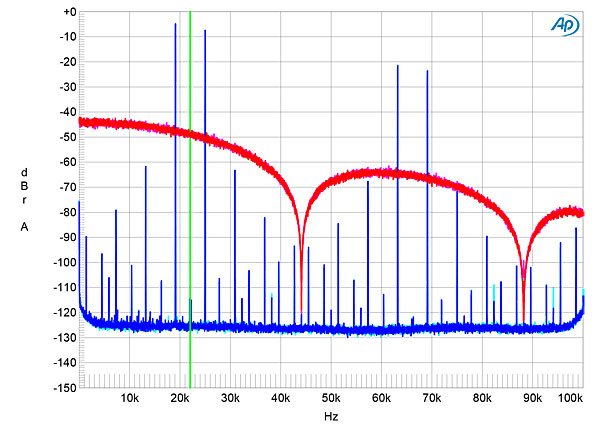
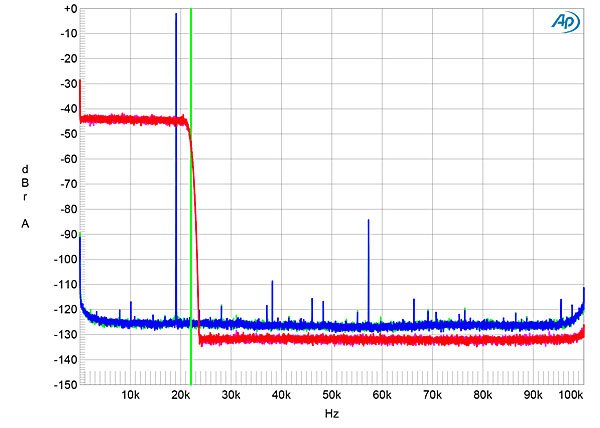
In NOS mode a gentle rolloff begins in the mid-treble with PCM data sampled at 44.1kHz, but starts a little higher in frequency with data at 96 and 192kHz (fig.6). The surprise, however, is that in DSD mode the Holo Spring’s frequency response extends no higher with 192kHz-sampled PCM data than it does with 44.1kHz data. This can be seen in fig.7, which compares the responses with 192kHz PCM data in NOS, OS, and OS PCM modes with that in DSD mode. The last rolls off sharply above 19kHz.
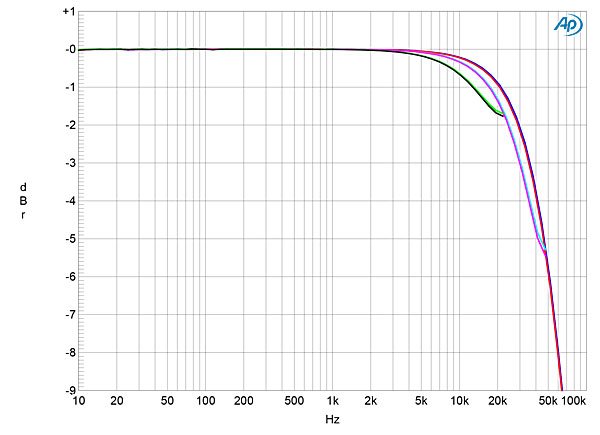
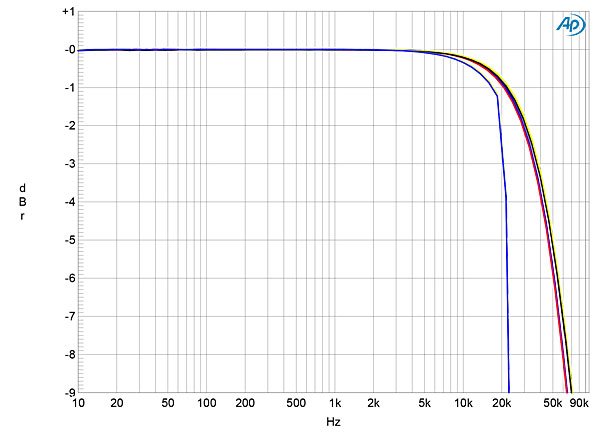
Channel separation was superb, at >125dB in both directions below 1kHz, and the Spring’s noise floor was both very low in level and commendably free from power-supply–related artifacts. A relevant issue with resistor-ladder DACs is the linearity error: Will a digital signal at, for example, –80dBFS be reproduced at the outputs by an analog signal the same 80dB down from full level? However, the Spring performed well in this respect (fig.8).
When I examined linearity, the error was negligible down to –60dBFS, and remained below 1dB down to 90dBFS. Increasing the bit depth from 16 to 24 with a dithered 1kHz tone at –90dBFS (fig.9) dropped the noise floor by 30dB. However, the many distortion harmonics visible in the 24-bit signal suggests something is not optimal in the Spring’s handling of low-level data with this bit depth. Perhaps the LSBs are being truncated. With undithered data representing a tone at exactly –90.31dBFS (fig.10), the three DC voltage levels described by the data were well resolved. With undithered 24-bit data, the result was a clean sinewave (fig.11).
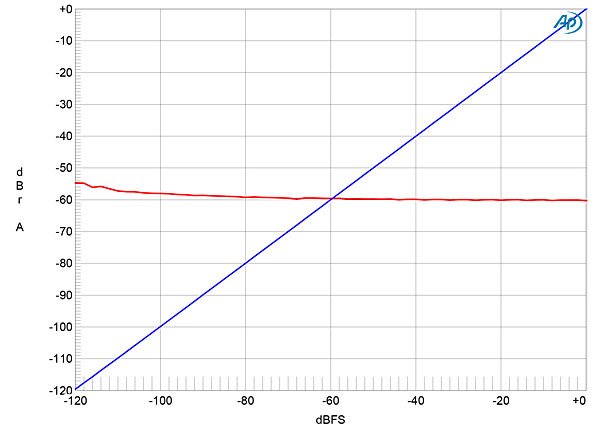
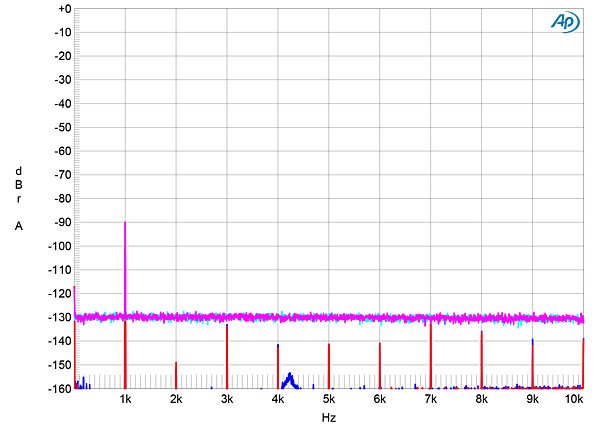


As suggested by figs. 4–5, harmonic distortion was very low. Even at maximum output into the punishingly low 600 ohm load, the distortion harmonics all lay at or below –114dB (0.0002%), though many higher-order harmonics are visible (fig.12). In NOS mode, the poor ultrasonic rejection gave rise to a multitude of aliased images with a full-scale mix of 19 and 20kHz tones (fig.13), and reducing the signal level by up to 10dB produced no change in the number of images. Fortunately, music rarely has significant energy toward the top of the audioband, and switching to the OS and OS PCM modes revealed that actual intermodulation distortion was very low (fig.14). It was even lower in DSD mode (fig.15), but that might be connected with the Spring’s lower maximum output level in that mode.
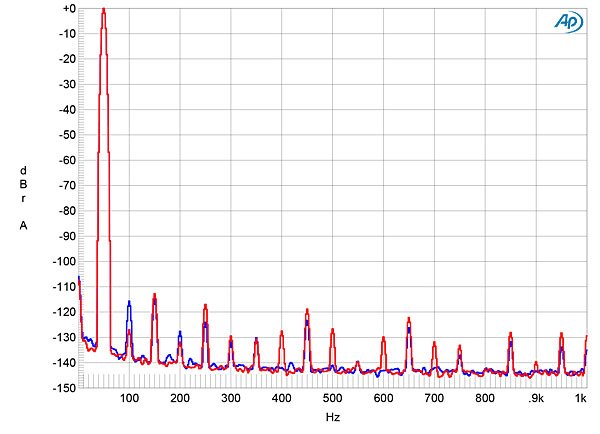


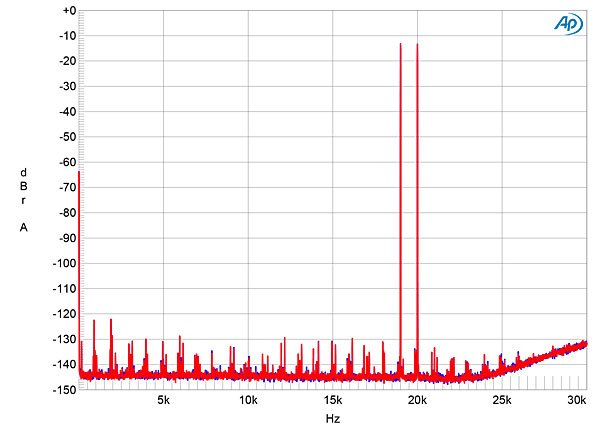
When I tested the Spring in NOS mode for its rejection of word-clock jitter, using undithered 16-bit J-Test data fed to the AES/EBU input, most of the odd-order harmonics of the low-frequency, LSB-level squarewave were at the correct levels, as shown by the sloping green line in fig.16. However, those harmonics closest to the spectral spike that represents the high-level tone at one-quarter the sample rate were exaggerated in level.
This behavior was identical when I repeated the test using the optical, coaxial, and USB inputs, and when I used 24-bit J-Test data, it appeared that the Spring in NOS mode introduced sidebands spaced at ±229.16Hz and at odd-order multiples of that frequency (fig.17). Switching to any of the oversampling modes gave a much cleaner spectrum with 24-bit data in the right channel (fig.18 red trace), but there were still problems in the left channel (blue).

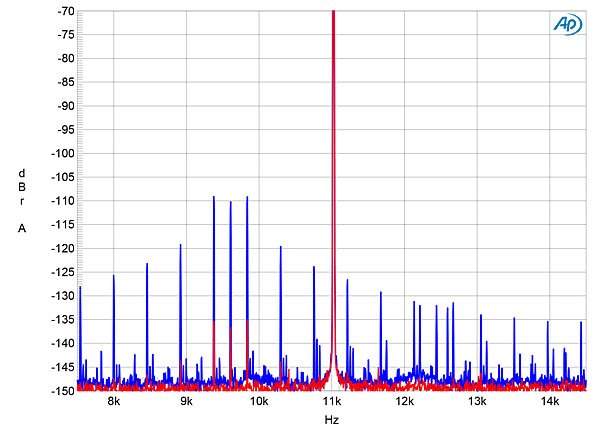
Art Dudley wrote about the HoloAudio Spring DAC in July 2018 (Vol.41 No.7):
Praise it all you want, but digital audio is still my second choice: In a life in which the enjoyment of art is infinite but the hours in which to do so are limited, and given the choice between listening to LPs and 78s on the one hand or files and CDs on the other, digital is a waste of my time: It doesn’t connect me with the music as well as analog does, period. In my experience, digital audio isn’t evil, merely banal.
But digital is getting better all the time, and part of my job description is to endure in meeting digital halfway, to give it a fresh chance every time out. But first I have to catalog and discard all of the defense mechanisms I’ve adopted without thinking—the wince before the blow, if you will—to make digital more palatable. In particular, because early digital sound was so damned bright, even when the glare isn’t there, my ears still squint. So it was that, during my first hour with the HoloAudio Spring “Kitsune Tuned Edition” Level 3 DAC,6 I thought: Is it my imagination, or is this thing a little . . . dark? It turned out to be the former.
The darkness was all in my head, a semisubconscious product of my expectations. I remember using my Sony SCD-777 SACD/CD player to listen to “Two Turns Home,” from guitarist David Grier’s Evocative (CD, Dreadnought 0901), then to an AIFF file made from that same disc, played through the HoloAudio DAC—and the latter sounded, undeniably, a lot richer. The electric bass was more rounded, the fiddle more substantive, the guitar more burnished in tone, and the recording as a whole was more listenable. I made a conscious effort to let down my guard, and found that nothing—and I mean nothing—in the music was hidden from me. The notes were no less apparent, the pitches no less distinct, the ensemble playing no less rhythmically accomplished than when listening to the CD.
Subtleties of bassist Victor Wooten’s technique and details of his fretless instrument’s sound were front and center, and Grier’s melodic variations rolled, colorfully and altogether beautifully, into aural view, one after the other. I was more than enchanted—I was involved. I couldn’t help but wonder: Was this uncommon musicality a consequence of HoloAudio’s similarly uncommon approach to digital processing? As Herb Reichert noted in his review of it in the May 2018 Stereophile, the Spring DAC Kitsune Tuned Edition” Level 3 is unusual, though not entirely unique, in using a resistive ladder to passively convert the incoming bitstream to AC voltage. Allied with this is a second and arguably equally crucial distinction: Although the user can apply to the incoming signal one of three different switch-selectable oversampling filters, in its default mode, the HoloAudio Spring plays music with no oversampling.
Again, I wondered: Is it a coincidence that one or both of those distinctions have been found in some of my all-time-favorite digital source components, including D/A converters from Audio Note, 47 Laboratory, and Wavelength . . . ? As Herb also pointed out, conversion via a resistive ladder can be accomplished by means of an integrated circuit—the Philips TDA-1540 family of chips, which flourished in the 1990s, being a prime example—or by discrete resistors. The latter route is extremely labor-intensive, requiring the tedious measuring and hand-selecting of every resistor used. Building a discrete-resistor ladder DAC is expensive for that reason, and because hand selection usually means discarding a certain number of out-of-spec parts. And if the builder wants to use boutique resistors . . . well, as the monkey said as he peed into the till, That’s running into money.
I’ve had the pleasure of listening to a Stereophile-recommended, Class A+ discrete-resistor ladder DAC: the TotalDAC d1-tube-mk2, which I heard at Michael Lavorgna’s music barn in the forests of New Jersey. It was sublime. It also cost €9100—in dollars, a five-figure price tag. So when Herb told us that HoloAudio’s discrete-resistor ladder DACs sell for as little as $1499, and that the subject of his review—the company’s all-out, silver-wired, Mundorf-capped “Kitsune Tuned Edition” Level 3—costs only $2499, the Holo became the rare digital source that I begged to hear. * * * So here I was, doing just that, feeding the Spring DAC with files from my Roon-equipped MacBook Air computer, connected via USB—in which case the Spring can handle PCM up to 32-bit/384kHz and DSD up to DSD512. I moved from acoustic guitar at 16/44.1 to solo piano at 24/96: Chopin’s Ballade in g, from Daniel Barenboim’s On My New Piano (AIFF file, Deutsche Grammophon 289 479 6724).
And here I could point to how the Holo put across the considerable size of Barenboim’s unique, straight-strung instrument, conceived by him and built by Chris Maene, in particular the texture and purr of its lowest strings, and how the sound of the recording space was realistically and, I dare say, naturally intertwined with the sound of the instrument, as opposed to sounding like tacked-on generic reverb. But the two things that most impressed me were the fact that the Spring DAC communicated how much Barenboim was enjoying playing the piece—you can just tell!—and how, at about 7:17 in, when he goes up an octave for a high B-flat, that note just hung in the air, as solid and as meaty as I’d expect a good LP to let it sound. I remember how Naim Audio’s founder, the late Julian Vereker, used to say that if a CD player could make just one disc sound good, then there was hope for digital. I’d settle for one note—and there it was.
All right, make it three things that most impressed me: What is that scary sound at 5:30 in the Chopin, and again at 5:33? Is Barenboim slamming his left foot down on the stage as he plays those chords, or is it a structural sound resulting from his having struck the keys so hard? I have no idea, but it was cool, and I’d certainly never before heard it from this file. It was time to throw at the Spring a few bad, or at least so-so, recordings. It sailed through them all, not only by making the best of badly recorded sound without throwing a blanket over it, but by playing the music so well and so convincingly that I was too charmed and entertained and delighted to devote my attention to audiophile froufrou. “Long Ago and Far Away,” from the dB’s’ Falling Off the Sky (AIFF from CD, Bar/None BRN-CD-202102), elements of which are recorded so close-up that it’s a little too in-my-face and borderline edgy through most DACs, was unbelievably good: sonically sparkly but not at all wince-inducing. And, for gosh sakes, Will Rigby’s drumsticks on his cymbals, recessed in the mix, sounded just like drumsticks on cymbals: You can’t teach a DAC that’s merely rolled-off on top to do that.
The listening described above was done without oversampling. For this Follow-Up I also relied on PCM rather than native DSD; the latter, according to distributor KitsuneHiFi, is heard at its best via the Spring’s I2S input, which would require a digital-to-digital USB-to-I2S converter (Kitsune sells such things, starting at $399) and an I2S-over-HDMI cable. My primary goal was to hear what a modern, zero-oversampling DAC sounds like, and in that context I was not only impressed, I was overcome with the sort of unexpected delight that discourages further acts of daring. (I’m one of those people who, on trying a new restaurant and finding a dish I like, never orders anything else.) But access to the Spring’s oversampling filters can be had with the press of a button, so I tried them, too. Relative to the believable color and life of the Spring’s music-making, all three of its oversampling filters added different amounts and flavors of death and dullness, blunting the sense of human force behind note attacks, sanding off all the randomness, and replacing the charged air around notes with something that sounded like it was molded from plastic. One example of the above came while listening to Tony Rice Plays and Sings Bluegrass (AIFF from CD, Rounder Select ROUCD 253).
Near the end of “I’ve Waited as Long as I Can,” Rice begins his solo with a D produced by bending his guitar’s B-string to that pitch before his pick attack: in non-oversampling mode, the tension involved in doing so was apparent; with each of the oversampling filters—especially the third, which oversamples all incoming digital signals, regardless of provenance, to DSD—the tension was nowhere to be heard. The above points to the only complaint I have about the HoloAudio DAC, though it’s less a complaint than a suggestion: Why not make a version of the Spring that dispenses altogether with the oversampling chip, and with the controls required to activate those filters? Maybe such a thing could sell for even less than $2499. Never mind that. I’m just happy that so relatively affordable a product has proven me wrong in the most agreeable way: The HoloAudio Spring “Kitsune Tuned Edition” Level 3 DAC is a revelation in every sense. As Herb said: Highly recommended.— Art Dudley
Find the Holo Audio DACs HERE!
